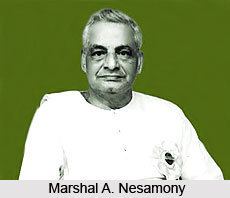Nationality Indian Died June 1, 1968 Parents Kesavan Appavu Nadar | Name A. Nesamony Role Political leader Ex-spouse Caroline Nesamony | |
 | ||
Born Education Maharaja's College, Ernakulam | ||
A. Nesamony, sometimes known as Marshal Nesamony, was a political leader from Kanyakumari district in Tamil Nadu, India. He was the second son of Kesavan Appavu Nadar, born on 12 June 1895 at Nesarpuram, Palliyadi in Vilavancode Taluk, Kanyakumari district. He graduated from Maharaja's College in Thiruvananthapuram, and studied at law college in Thiruvananthapuram. He began practising in 1921. He was among those involved with the merger of four Taluks from Southern Travancore to Tamil Nadu. Marshal Nesamony is affectionately called as Kumari Thanthai (Father of Kanyakumari district).
Contents
Early life
He was educated at Scott Christian High School and then at C.M.S. College in Tirunelveli. While studying at C.M.S. College, he was elected as students' leader, which provided him with an opportunity to attend the Congress Conference at Calcutta. Influenced by Mahatma Gandhi at that time, he chose to wear only Khadi cotton dresses throughout his life. He graduated with a BA degree from Maharaja's College, Trivandrum, after which he began teaching, spending a year at Kurnool Bishop Heeber High school. He later became headmaster at Salvation Army Middle School in Trivandrum. Simultaneously he pursued his law studies at Government Law College, Thiruvananthapuram. He married in September 1914.
Legal practice
Nesamony registered as a lawyer at Nagercoil Sessions Court in 1921. He became a criminal lawyer at Nagercoil Bar. He was elected as the president of Nagercoil Lawyers' Association in 1943. In the same year he was also elected as the chairman of Nagercoil Municipal Council.
Public life
Political career
He was a Member of Parliament elected from Tamil Nadu. He was elected to the Lok Sabha from Nagercoil constituency as an Indian National Congress candidate in 1951, 1962 and 1967 elections.
He was also a Member of the Legislative Assembly. He was elected to the Tamil Nadu legislative assembly as an Indian National Congress candidate from Killiyur constituency in 1957 election.
Background
Feudalism prevailed in the erstwhile state of Travancore. The jenmi system protected the socioeconomic and political status of the upper castes only, while the lower castes were exploited in many ways. Events such as the Upper Cloth Controversy and the Temple Entry Proclamation were reactions to this.
Events
A consequence of the social oppression and political repression was an ongoing campaign for recognition by the affected groups during the later nineteenth- and early twentieth-centuries. This was evidenced by, for example. the creation of the Nair Service Society and the SNDP.
The agitation intensified after Indian independence. A campaign was launched under the auspices of a political movement called the Travancore Tamil Nadu Congress (TTNC), to fight against the social ills that existed in the former state of Travancore. The TTNC later converted into a political party in order to contest elections. It culminated in the formation of Kanyakumari district and its subsequent merger with Tamil Nadu on 1 November 1956 during the linguistic reorganisation of states.
Immediately thereafter, the TTNC merged with the Indian National Congress and became fully integrated with the national mainstream.
Death and legacy
Nesamony died on 1 June 1968 while serving as a member in the Lok Sabha. This caused a by-election in his Nagercoil constituency in 1969, which was won by Kamaraj.
There have been various tributes paid to his memory since that time. These include:
